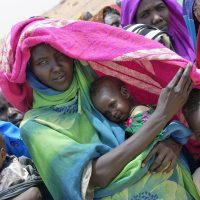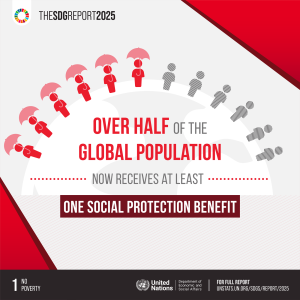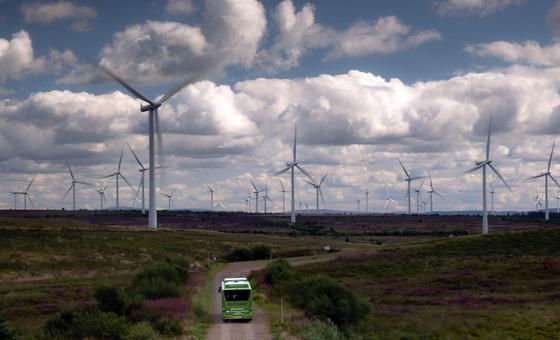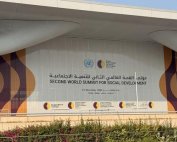Eradicating extreme poverty for all people everywhere by 2030 is a pivotal aim of the Sustainable Development Goals. Extreme poverty, defined as surviving on less than US$3.00 per person per day at 2021 purchasing power parity, has witnessed remarkable declines over recent decades.
However, in 2025, 808 million people – or 1 in 10 people worldwide – were living in extreme poverty, an upward revision from earlier estimates because of the updated poverty line. If current trends continue, 8.9 per cent of the world’s population will still live in extreme poverty by 2030.
A shocking revelation is the resurgence of hunger levels to those last observed in 2005. Equally concerning is the persistent increase in food prices across a larger number of countries compared to the period from 2015 to 2019. This dual challenge of poverty and food security poses a critical global concern.
Why is there so much poverty
Poverty has many dimensions, but its causes include unemployment, social exclusion, and high vulnerability of certain populations to disasters, diseases and other phenomena which prevent them from being productive.
Why should I care about other people’s economic situation?
There are many reasons, but in short, because as human beings, our well- being is linked to each other. Growing inequality is detrimental to economic growth and undermines social cohesion, increasing political and social tensions and, in some circumstances, driving instability and conflicts.
Why is social protection so important?
Strong social protection systems are essential for mitigating the effects and preventing many people from falling into poverty. The COVID-19 pandemic had both immediate and long-term economic consequences for people across the globe – and despite the expansion of social protection during the COVID-19 crisis, 47.6 per cent of the world’s population – about 3.8 billion people – are entirely unprotected, including 1.4 billion children in 2023.
In response to the cost-of-living crisis, 105 countries and territories announced almost 350 social protection measures between February 2022 and February 2023. Yet 80 per cent of these were short-term in nature, and to achieve the Goals, countries will need to implement nationally appropriate universal and sustainable social protection systems for all.
What can I do about it?
Your active engagement in policymaking can make a difference in addressing poverty. It ensures that your rights are promoted and that your voice is heard, that inter-generational knowledge is shared, and that innovation and critical thinking are encouraged at all ages to support transformational change in people’s lives and communities.
Governments can help create an enabling environment to generate pro- productive employment and job opportunities for the poor and the marginalized.
The private sector has a major role to play in determining whether the growth it creates is inclusive and contributes to poverty reduction. It can promote economic opportunities for the poor.
The contribution of science to end poverty has been significant. For example, it has enabled access to safe drinking water, reduced deaths caused by water-borne diseases, and improved hygiene to reduce health risks related to unsafe drinking water and lack of sanitation.

- The updated international poverty line of $3.00 resulted in a revision in the number of people living in extreme poverty from 713 to 838 million in 2022. (World Bank)
- If current trends continue, 8.9 per cent of the world’s population may still be living in extreme poverty by 2030 and only one in five countries will have halved their national poverty levels.
- For the first time on record, over half of the world’s population now receives at least one form of social protection benefit. Despite this milestone, 3.8 billion people remain uncovered.
- The share of government spending on essential services, such as education, health and social protection, is significantly higher in advanced economies than in emerging and developing economies.
- Guaranteeing basic social security floors in low- and middle-income countries requires an additional $1.4 trillion annually, or 3.3 per cent of their aggregate GDP in 2024.
- A surge in action and investment to enhance economic opportunities, improve education and extend social protection to all, particularly the most excluded, is crucial to delivering on the central commitment to end poverty and leave no one behind.
1.1 By 2030, eradicate extreme poverty for all people everywhere, currently measured as people living on less than $2.15 a day
1.2 By 2030, reduce at least by half the proportion of men, women and children of all ages living in poverty in all its dimensions according to national definitions
1.3 Implement nationally appropriate social protection systems and measures for all, including floors, and by 2030 achieve substantial coverage of the poor and the vulnerable
1.4 By 2030, ensure that all men and women, in particular the poor and the vulnerable, have equal rights to economic resources, as well as access to basic services, ownership and control over land and other forms of property, inheritance, natural resources, appropriate new technology and financial services, including microfinance
1.5 By 2030, build the resilience of the poor and those in vulnerable situations and reduce their exposure and vulnerability to climate-related extreme events and other economic, social and environmental shocks and disasters
1.A Ensure significant mobilization of resources from a variety of sources, including through enhanced development cooperation, in order to provide adequate and predictable means for developing countries, in particular least developed countries, to implement programmes and policies to end poverty in all its dimensions
1.B Create sound policy frameworks at the national, regional and international levels, based on pro-poor and gender-sensitive development strategies, to support accelerated investment in poverty eradication actions
Related News
Syria’s future under threat from acute funding shortages
Hopes for a peaceful future in post-war Syria are at risk as funding for basic services dries up, the World Health Organization (WHO) said on Tuesday. Read Full Story on UN News
New climate pledges do little to correct global warming projection, UN warns
Available new climate pledges by governments have only slightly lowered global temperature rise over the course of this century, leaving the world on the path to a serious escalation of climate risks and damages. Read [...]
LIVE from Doha: Second World Summit for Social Development
Leaders, policymakers and civil society representatives have gathered in Doha for the Second World Summit for Social Development, with the aim of renewing global commitments to inclusion, dignity and social justice. UN News is on the ground, bringing you live updates, key highlights and human stories from inside the conference halls and beyond. Follow this page for rolling coverage throughout the Summit. App users can follow the coverage here.
Related Videos
Press Release | World leaders in Doha unite in call to action for more just and inclusive societies
Against a backdrop of geopolitical tensions and rising inequalities, world leaders at the Second World Summit for Social Development today adopted the Doha Political Declaration, signalling renewed global commitment to building more just and inclusive societies.
As global crises deepen, leaders in Doha urge shift from promises to action
As global challenges deepen, governments, civil society and international partners convened in Doha on Monday to highlight concrete solutions to advance social development and confront some of today’s most urgent crises – from widening hunger [...]
Fresh push to fight toxic mercury pollution underway
Representatives from countries around the world are working together to reduce mercury pollution and protect people and the planet, at a major international meeting which got underway on Monday in Geneva, Switzerland. Read Full Story [...]
Surviving the next pandemic could depend on where you live
A new global report warns that inequality is increasing the world’s vulnerability to pandemics, making them more deadly, more costly and longer lasting – and where you live, could determine how badly impacted you are. [...]









